Western front: French self-confidence, Germanic blitzkrieg dreams and the rout of Belgium
With the beginning of the war in Germany, a festive mood reigned. The Germans hoped to win quickly and easily, to become the complete masters of Europe. The press wrote about the “war before the autumn leaf fall”, “a refreshing happy war” (the expression of Crown Prince Wilhelm). No one guessed that the war would be long, exhausting, leading to a mass of victims, the depletion of the country and the fall of the German Empire. Similar sentiments prevailed in Austria-Hungary and the Entente powers: England, France and Russia.
It must be said that the beginning of the war in Western Europe was accompanied not only by a surge of patriotic, hats and moods, but also by excesses of violence against outsiders. In England and France, the subjects of hostile powers immediately interned. In Austria-Hungary, the Russians were sent to concentration camps. It was a special tragic page. stories. The exception was made only by some Russian revolutionaries. So, Lenin and Trotsky were under the tutelage of high-ranking and influential people. With all the comforts they were taken abroad, so that the patriotic crowd would not harm such useful people.
The whole tragedy with the Russian people occurred in Germany. There were many Russians in Europe, representatives of the nobility, intelligentsia and bourgeoisie liked to spend time in Germany and other countries. Who richer went to France. Poorer or amateurs traveled to Germany to rest and receive medical treatment in boarding houses, famous German clinics. We went on excursions, to study. In the summer, tens of thousands of seasonal farm laborers from the Kingdom of Poland, the Baltic states and the Western Russian provinces came to Prussia. They all became victims of the war. The world was instantly destroyed. All peace plans are crossed out. Many destinies were ruined.
Only in Berlin alone there were about 50 thousand Russians. Even before the declaration of war, they stopped accepting rubles. Patients were discarded from clinics. The hotels swept the arrests of "spies". In the streets, in a single moment, angry crowds caught “Russian spies”, beat them, raped and killed them. Someone managed to save the police, collecting battered men and raped women. Since there were not enough police stations and prisons for the Russians, they were taken to military units. Men of military age did not even interned, and declared prisoners of war. At the same time, people received the whole bunch of “charms” of the attitude of “highly developed, civilized Europeans” to “Russian barbarians”. They scoffed at them, took away valuable things. In some places, there was violence against women and girls. Forced them to undress, searched. Men who tried to protect their wives, loved ones, daughters, were brutally beaten, shot. After a nightmare, women, children, and the elderly, through the mediation of neutral countries, still allowed Germany to leave. On departure, the Germans continued to mock the exhausted and hungry people. They were beaten, driven by blows, "searched" women and girls.
And so brutally appealed "cultural public", representatives of the educated, wealthy segments of the population of the Russian Empire. With the farm laborers in Prussia, they did not observe this appearance of order. They were robbed, men were sent to concentration camps, women were raped and sent to work on the same estates and farms, but without pay, as slaves. Those who tried to protest, to resist, without ceremony killed.
It is impossible not to say that with the growth of confrontation in the modern world, when global conflict has already erupted, but the berries are still ahead, many Russian residents of "highly developed" Western countries can experience a similar fate. The current Western crowd is no better than the European inhabitants a century ago (in some respects even worse, more spoiled). Her wild instincts are held back only by the laws and the police. When it is possible to cut and beat "strangers", everything can repeat, only the scale will be wider. Russians in Germany, England, Canada and other countries of Western civilization (in the West Russians record everyone, including visitors from Ukraine, the Caucasus and Central Asia) who have citizenship or simply live and work in Western states for years, will inevitably become victims of a global confrontation. The fact that many of them have long considered Russia to be a foreign country, they do not like it, even hate it, or have been robbed and continue to rob Russia, will not worry anyone. Under protection will get only a few valuable shots.
In the Russian Empire, in contrast to the “highly developed countries” of Europe, there was no such hatred towards the Germans. Separate anti-German excesses occurred, such as the pogrom of the empty mansion of the German embassy (the staff had already left). However, such pogroms immediately stopped by the police. There were 170 thousand German and 120 thousand Austrian nationals in Russia, neither murders nor mass arrests. “Barbarous Russia” was the only belligerent power that allowed citizens of hostile powers to simply leave. Some people took care of changing their citizenship and lived quietly in Russia.
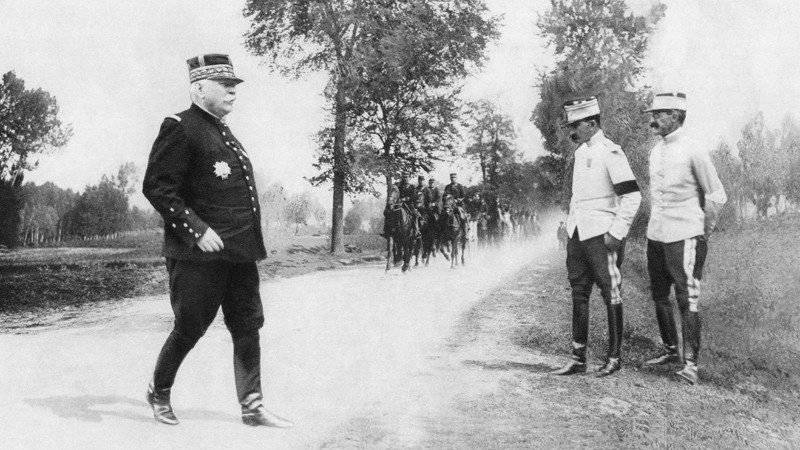
Commander-in-Chief of the French Army, Joseph Jacques Joffre. 1914 year.
War plans
The essence of the German plan of war was to surround and destroy the French army (by a single general battle (strategic operation)The Great War: The Schlieffen Plan). After the defeat of France, the main forces planned to transfer to the Eastern Front and defeat Russia. The operation to bypass and encircle the French army was to carry out the reinforced right wing of the German army, which was advancing through the territory of Belgium. The left wing of the German army was supposed to restrain the onslaught of the main forces of the French army. Schlieffen’s plan envisaged maximum reinforcement of the right flank, the left flank could even retreat to lure the enemy, facilitate the coverage of the French army with the right flank. In the east, they wanted to leave a small barrier of landwehr parts.
However, part of the German command did not want to risk it, they were supported by the industrial circles, who feared severe destruction and devastation of the highly industrialized Alsace-Lorraine region and the Prussian youth who feared the fall of East Prussia. Under their pressure, the Schlieffen plan was modernized by Moltke. The main idea of the main strike on the right flank through Belgium was maintained. To the detriment of the strike force on the right flank, the left flank was significantly strengthened. In Alsace and Lorraine, 8 army corps were now deployed - 320 thousand people (according to Schlieffen's plan there were 4 and a half). The overall balance of forces between the northern and southern Germanic groups on the western front began to equal 3: 1 (for Schlieffen it was equal to 7: 1). In addition, an entire army was deployed on the Eastern Front, not counting reserve divisions, landwehr, and reinforced garrisons of fortresses.
The French plan was passive and expectant (The Great War: Entente Strategy). The French dispersed the forces of their army, and the actions of their troops depended on the plans of the enemy. The French serf system was supposed to hold the enemy offensive. It must be said that the French attached great importance to their fortresses. The main fortresses in the east were Maubezh, Verdun, Toul, Epinal and Belfort. The strengthened strip Verdun - Belfort was considered impregnable. In the area of Dijon, Reims, Laon located the second strip of fortifications. In Belgium, the fortresses of Liege, Namur and Antwerp were of strategic importance. On the way from Paris to the Belgian border also had fortresses, although in this direction (it was considered secondary) they were obsolete.
While the Germans held back the fortresses and the covering corps, the French armies were concentrated and deployed. The troops deployed in two echelons, in the presence of strong flanks, which could be deployed in the direction of both Belgium and Switzerland. The deployment of troops ensured a frontal attack through the territories of Luxembourg and Alsace-Lorraine. The main idea of the French plan No. 17 (the British were guided by this plan as well) was to concentrate troops on the central front as quickly as possible in order to deliver a preemptive strike to the German army. The French were planning to take Alsace and Lorraine with one blow, and through Mainz to launch an offensive in the Berlin direction. French industrialists insisted on the primary importance of capturing Alsace and Lorraine. However, the beginning of the war completely buried these self-confident plans.
The French military had information about the German plan of attack. Back in 1904, one of the early versions of the Schlieffen plan was obtained. However, the majority of French military leaders considered it to be misinformation, that the Germans simply did not have the strength for such a wide maneuver. Given the impact of the French army in the center of the front and the Russian offensive on the Eastern Front, the German Empire should not have enough troops to implement this plan. In addition, in Paris they believed that Berlin would not violate the neutrality of Belgium - this led to a clash with Britain, which guaranteed the inviolability of Belgium.
The French generals believed that at first the Germans would rush to the East, strike at Russia. If the Germans hit France first, then the decisive oncoming battle will take place in Lorraine. In addition, the French did not believe in the rapid mobilization of the German army and the strength of the German reserves. And without rapid mobilization and a powerful reserve it was impossible to launch an offensive through Belgium. French intelligence produced data on the German reserve, but they were also perceived skeptically. The French generals overestimated the power of the French army and underestimated the enemy. The French believed that one powerful onslaught of the Russian and French armies would crush the enemy. Germany, between the hammer and the anvil, quickly exhales and capitulates. Therefore, in connection with the offensive of the German corps through the Belgian territory to Paris, the French command had to abandon the plan number 17, and take countermeasures on the move.
The British at the beginning of the war planned to land the expeditionary force in France - 4-6 divisions (in the first stage, about 80 thousand people). British troops were to cover the left flank of the French army. Their task also included the protection of the northern ports of France. The British fleet had to solve the problem of the continental blockade of the German Empire. If the German fleet would decide on a direct battle, the British were to destroy it.
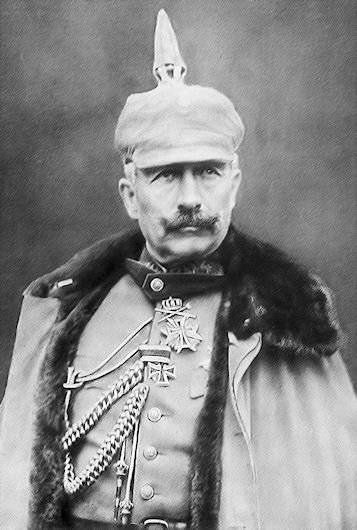
German Kaiser Wilhelm II
Mobilization
In Austria-Hungary, mobilization against Serbia began on 26 on July 1914. At the same time, pre-mobilization activities began in Germany: military units returned from training camps, orders were given to guard the railways, and to purchase grain in the concentration areas. On July 30, a “war-threatening situation” was declared, border guards were strengthened, and six age classes of reservists were called for. As a result, by the beginning of the official declaration of war, Germany had already completed most of the mobilization activities. On the Belgian border, a grouping was concentrated enough to take the key fortress of Liege (it defended the crossings over the Meuse) and open the road to the entire right wing of the German army.
Before all, even 24 July was brought to combat readiness of the British fleet. 25 July squadron commanders were instructed to be ready to begin hostilities. The British began to observe the German coast. The French began to take action to mobilize in the evening of July 25. The French Minister of War Messim ordered the General Staff officers and corps commanders to return to their posts. July 26 orders appeared to the military governor of Paris and the corps commanders on the introduction of martial law. The holidays of officers and soldiers were canceled, the previously planned peaceful movements of the units, the railways were alerted, and censorship was strengthened. Began partial mobilization. The commander of the 19 Corps, stationed in North Africa, was instructed to prepare as much of a reserve as possible from the Tunisian and Algerian shooters. 29 July in the areas bordering Germany called reservists. 31 July to the border began to bring up the cover body.
1 August 1914 in France was ordered to mobilize. On the Franco-German border, transitions of advanced units began. Mobilization at the border was covered by units of six corps and six cavalry divisions, they were deployed from the Belgian border to Belfort. 5 August mobilization was completed and began transporting troops to areas of concentration. The concentration and regrouping of all armies in France was completed by August 19. France exhibited 5 armies and 1 cavalry corps with 4 thousand guns. French forces numbered about 1,3 million.
Faster than all completed mobilization in England and Belgium. In Belgium, the mobilization was carried out as soon as possible. As soon as information was received about the Austrian ultimatum of Serbia, Belgium immediately mobilized the army. July 31 The Belgian army was mobilized and concentrated between the rivers Maas, Zhetoi and Dil. The Belgian army had both 6 infantry and 1 cavalry divisions. The total number of the Belgian armed forces at the time of the mobilization was 375 thousand people (a significant part of the army was concentrated in the fortresses and was in reserve) with 312 guns in the field army.
The British first put on alert the fleet. Having a small expeditionary corps in peacetime in England, the British replenished it with small units and completed the mobilization of August 7. Then began the transfer of British troops to the French ports of Boulogne, Le Havre and Rouen, and their concentration in the Maubeuge region, on the left flank of the French army. The British deployed two infantry corps, one cavalry division, infantry and cavalry brigades - 87 thousand people, with 328 guns.
I must say that part of the English leadership did not want the expeditionary force to become an appendage of the French army. It was proposed to land troops in Belgium or even to conduct a landing operation in East Prussia. Nevertheless, they decided to fight in France, but they set up a weak grouping in order not to completely expose England before the arrival of the troops from the colonies. In addition, the British were not to obey the French generals, to make decisions on their own. War Minister Kitchener insisted that the main goal was to preserve the army. With a serious threat, commander-in-chief of the British expeditionary forces in France, Field Marshal John French, had to consult with the government. As a result, there was no consistency between the French and British military commanders in the first year of the war, which had an extremely negative effect on the course of military operations.
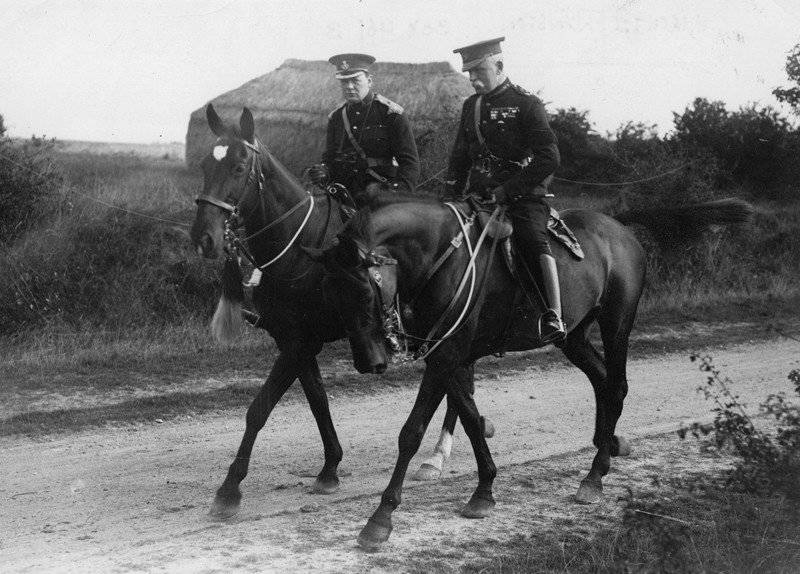
Winston Churchill and General French on maneuvers. 1914 year.
In Germany, the Kaiser signed a decree on mobilization on August 1. The first day of mobilization was considered August 2. According to the German plan, the troops were to begin hostilities immediately, before the completion of mobilization. Luxembourg was necessary to take to control the railways, and Liege - to occupy the crossings along the river. Meuse and further invasion of France. Germany, even before the official mobilization was announced, concentrated part of the troops on the border: the Richthoff 1 Cavalry Corps (Guards and 5 Cavalry Divisions) and six infantry brigades of different 1 and 2 armies under the command of General Emmich were concentrated on forces ; on the Belgian border; 4-th cavalcourse of General Hohlen and 16-I infantry division - on the Luxembourg border; The 3 th cavalcourse of General Frommel (Bavarian, 7 th and 8 th cavalry divisions) - in Lorraine.
In addition, already in peacetime, the 8, 16, 21, 15, 14 corps covered the border. 5 August mobilization was completed. The transportation of troops to the concentration areas began. By 17 August the German army was concentrated. Germany deployed against France 7 armies and 4 cavalry corps, up to 5 thousand guns. Total group of German troops consisted 1,6 million. Thus, France and Germany ended mobilization almost simultaneously. Only Germany launched an offensive before the completion of all mobilization activities.
The French are attacking
Deploying armies
France, England and Belgium. In connection with the data obtained on the German offensive through Belgium, the deployment plan of the French troops was somewhat modified. The French army under the command of General Joseph Joffre under Chief of Staff General Berthelot turned to the 20 of August. Front Belfort, r. Sambre, the length of 320 kilometers.
1-I army of General Dubylya (5 army corps, 2 cavalry divisions) was located in the area of Belfort and Provencher, occupied the passes. The 2 Army of General Castellno (3 Army Corps, 7 Reserve Divisions, 2 Cavalry Divisions) deployed on the front of Luneville, Serres, Monsel and Pont-à-Musson. The 3 Army of General Ryufe (3 Army Corps and 2 Cavalry Division) was deployed on the front of Eten, Zhamets. In its rear, in the Verdun area, 7 reserve divisions were located. The 4 Army of General Langl de Kari (one colonial corps, 5 army corps, 2 reserve and 2 cavalry divisions) moved into the area between the Meuse and the Belgian border from Monmedy to Charleville. General Lanresaz's 5 Army (4 Army Corps, Sordé Cavalry Corps — 3 Cavalry Divisions, two separate infantry and 3 reserve divisions) advanced into the area between the Maas and Sambra rivers. The cavalry corps of Sorde was located on the left bank of the Sambre, south of Senef.
In addition, 1 Infantry and 4 reserve divisions were concentrated. In the Paris garrison there were two reserve divisions. On the far left flank, on the border with Belgium and right up to the sea (Dunkirk), there was a group of territorial divisions of General d'Amad (81, 82, 84 and 88 territorial divisions). In total, the French army consisted of 21 army corps, 10 cavalry, 25 reserve and 4 territorial divisions, or about 1 million 320 thousand people. The main forces (1-I, 2-I and 3-I armies) were deployed in the area of Alsace-Lorraine, where they planned to deliver the main attack. On the Belgian border were the 4-I and 5-I armies. In this area, they planned to deliver a blow through the Ardennes.
The British were delayed due to technical problems with the landing, and only 20 of August reached the line of the Maubeuge Fortress. The Belgian army was under the command of King Albert I, the General Head of the General Staff was General Cellier de Moranville. The army was concentrated in the area of Brussels, Liege and Namur. The main forces of the Belgian army were located on the rear lines along the rivers Zheta, Dil (Dale). The 3 Infantry Division was advanced to the forefront of Liege, and the 4 Division strengthened the Namur garrison.
In general, the French troops were dispersed along the whole front, without clearly expressing them in any direction. The two main blows, north and south of Metz, were not adequately prepared and secured. By the time the French and British had completed the transfer and redeployment of forces, the German troops 2 occupied Luxembourg on August 8, August 4 invaded Belgium and August took the "impregnable" Liege. 16 August Germans entered Brussels and laid siege to Antwerp. Soon Namur also fell.
Source: Kolenkovsky A. The maneuverable period of the first world imperialist war 1914 M., 1940.
Germany. The commander-in-chief of the German army was Kaiser Wilhelm II. The Chief of the General Staff was Helmut Johann Ludwig von Moltke (Moltke the Younger). The Germans deployed 7 armies at the front in 380 km from Krefeld to Mülhausen. The 1 Army under the command of General Kluk (3 Army and 2 Reserve Corps, 3 Landwehr Brigade) developed in the Krefeld-Berchheim area. General Bülow's 2 Army (Guards, Guards Reserve, 3 Army and 2 Reserve Corps, 2 Landweaver Brigades) was concentrated in the Aachen-Blankenheim area. The 3 Army of General Gausen (3 Army, one reserve corps, and one Landwehr Brigade) - Prum area - Neuerburg. Albrecht’s Duke of Württemberg’s 4 Army (3 Army and 2 Reserve Corps, 1 Landwehr Brigade) concentrated in the Luxembourg-Trier region. The 5 Army of the German Wilhelm Crown Prince (3 Army and 2 Reserve Corps, 5 Landwehr Brigades) —Diedenhofen District, Lebach. The 6 Army of the Bavarian Ruprecht Crown Prince (3 Bavarian, 1 Bavarian Reserve, 1 Army Corps and 1 Landwehr Brigade) deployed in the Saargemünd - Château-Salen region. The 7 Army of General Geringen (2 Army, 1 Reserve Corps, 4 Landwehr Brigade, and 1 separate infantry regiment. 7-I army occupied a vast area from Freiberg to Strasbourg.
In addition, at the disposal of the German command was 4 cavalry corps. The Marnica 2 Cavalry Corps (three cavalry divisions, 5 Jaeger battalions) was deployed in the Aachen, Malmedy area. The 1 Cavalry Corps of Richthofen (Guards and Cavalry Divisions, Guards Chasseurs, Guards Rifle and 3 Chasseurs Battalion) was located in the Luxembourg region. Hohlen's 4 Cavalry Corps (two cavalry divisions and 2 Jaeger battalions) stood in the area south-west of Diedenhofen. FromNF's 3 Cavalry Corps (2 cavalry and Bavarian cavalry divisions, 2 Bavarian Jaeger battalion) was located in the Saarburg region.
In total, the German army had 22 army, 12 reserve and 4 cavalry corps and other formations. A total of about 1,6 million people (including fortress garrisons, rear units, etc.). Two thirds of all German forces north of Metz, where about 200 million people were located at the front of the 1,1 km. These forces were supposed to strike the main blow. The 1, 2, and 3 German armies (about 700 thousand people) were preparing to invade through Belgium. The central grouping - the 4-I and 5-I armies (400 thousand people), was supposed to support their blow through the Ardennes. On the left wing were the 6-I and 7-I armies (about 320 thousand people), who were also assigned the task of conducting active hostilities. The German army planned to actively advance in order to defeat the enemy as soon as possible. However, the strike through Belgium did not have a full supply of forces and means, which eventually led to the failure of the German Blitzkrieg in France.
To be continued ...
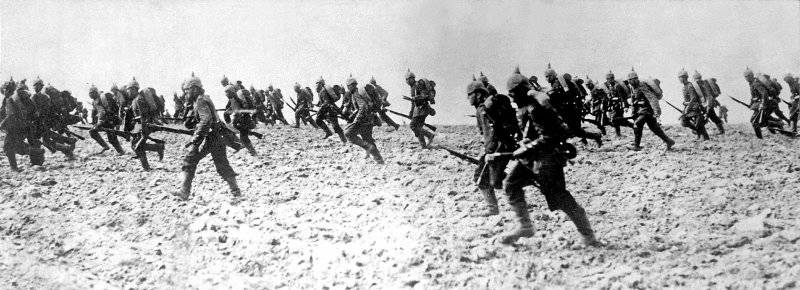
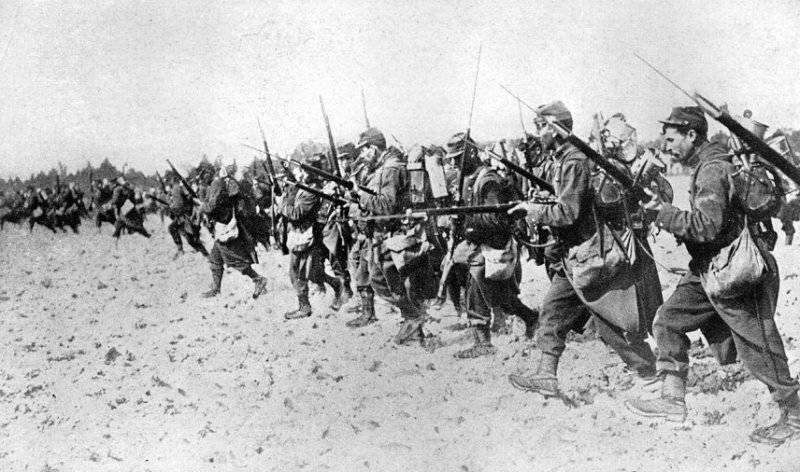
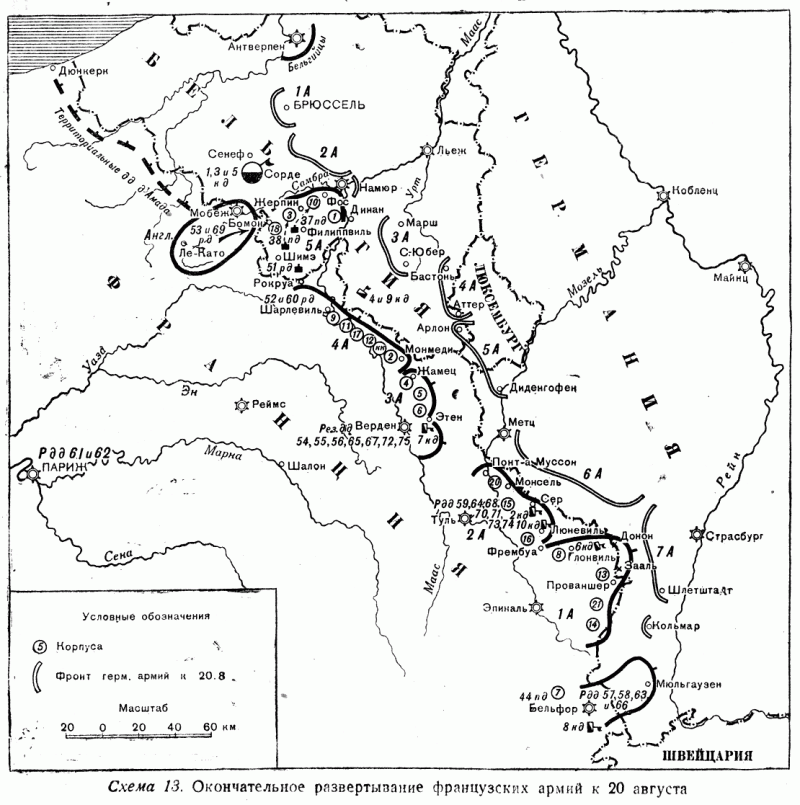
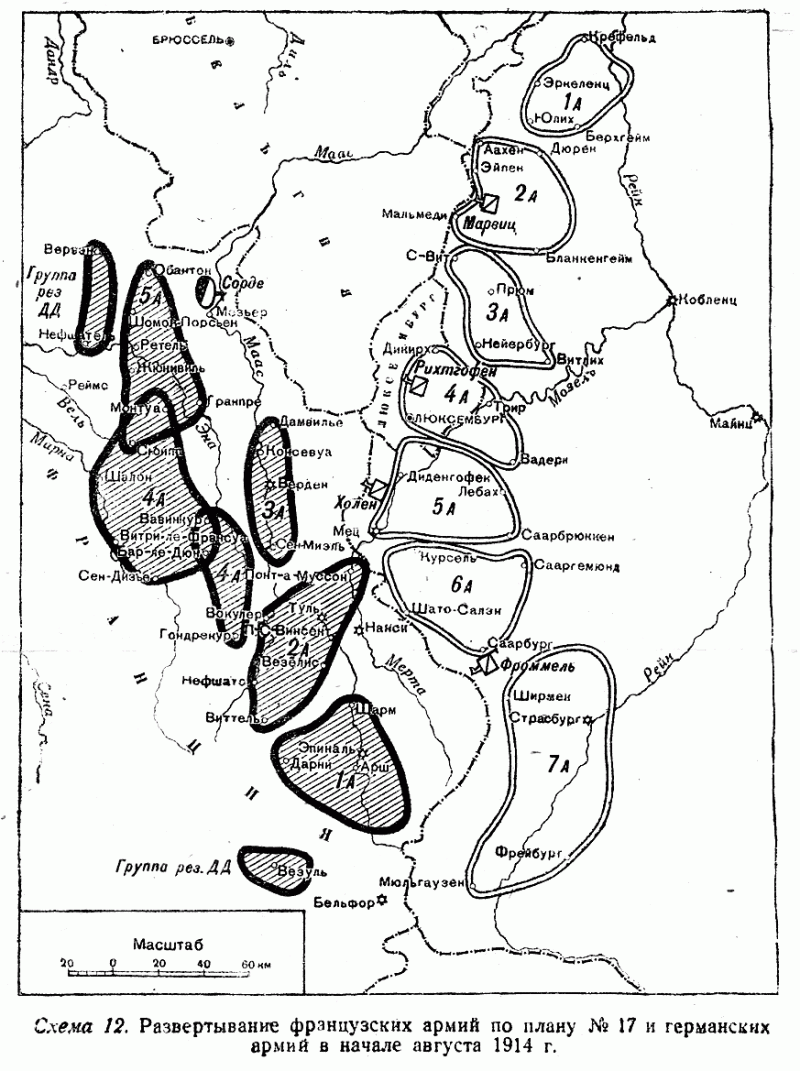
Information